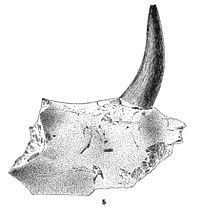Order Crocodiles | Class Reptilia Phylum Chordata | |
 | ||
Genus †ThecachampsaCope, 1867 Similar Kentisuchus, Gavialosuchus, Tomistominae, Megadontosuchus, Ikanogavialis | ||
Thecachampsa is an extinct genus of tomistomine crocodylian. Fossils have been found from the eastern United States in deposits that are between late Oligocene and Middle Pleistocene in age. The type species is T. antiqua. Several other species have been erected. Those named in the 19th century were distinguished primarily by the shape of their teeth, and have since been combined with T. antiqua. More recently erected species were reassigned from other tomistomine genera, although their assignment to Thecachampsa has since been questioned. The holotype of T. antiqua is an isolated tooth of little diagnostic value, making the assignment of any other body parts to the genus, including skulls and vertebrae, questionable.
Contents
Description
Thecachampsa, like other tomistomines of the Oligocene and Miocene, was considerably larger than living crocodilians. Like living gharials, it had a long, slender snout. The teeth were long and recurved. Unlike its living relatives, Thecachampsa was marine, inhabiting estuaries and shallow coastal waters. Other marine fossils such as sea snail and bivalve shells, shark teeth, and barnacles have been found alongside remains of Thecachampsa and similar tomistomines.
Species
The type species of Thecachampsa, T. antiqua, was first described in 1852 by American paleontologist Joseph Leidy, who referred to it as Crocodylus antiquus in the Journal of the Academy of Natural Sciences of Philadelphia. The holotype, which served as the basis for Leidy's first description, was a tooth found in the Calvert Formation of Virginia. Leidy also described additional material including several teeth and osteoderms, two vertebrae, a rib, and an ungual phalanx or claw bone. On the basis of these specimens, the new genus Thecachampsa was erected by Edward Drinker Cope in 1867.
Crocodilian material found from Miocene deposits in the eastern United States has often been attributed to Thecachampsa, even isolated teeth with few distinguishable features. In 1867, Cope named two new species of Thecachampsa: T. contusor (occasionally misspelled T. contusa) and T. sericodon. T. sericodon was distinguished from T. antiqua by its slender, curved teeth, each with a sharp edge near the base of the posterior margin (T. antiqua only possessed sharp edges along a small area near the tip of the posterior margin). In 1869, Cope named a fourth species, T. sicaria, from a jaw fragment and a dorsal vertebra. Unlike those of other species, the teeth of T. sicaria were lenticular (lens-shaped) in cross section with sharp cutting edges. That year, Othniel Charles Marsh named another species of Thecachampsa, T. squankensis, after the place of its discovery, Squankum, New Jersey. Cope named a new species, T. fastigiata, in 1870 as a reassignment of Crocodylus fastigiatus, named by Leidy in 1852. American geologist William Bullock Clark of the Maryland Geological Survey named a fifth species, T. marylandicus, in 1895. These species were distinguished from one another primarily by differences in the shape of the teeth, the most common material found. The genus was synonymized with Crocodylus in 1973, but has since been regarded as valid.
In 2001, A.C. Myrick synonymized Gavialosuchus americanus, another tomistomine from the eastern United States, with T. antiqua. Myrick also synonymized Tomistoma lusitanica, a tomistomine from Portugal, with Thecachampsa. The genus name Thecachampsa had priority over the other two, as it was erected earlier. However, because the holotype tooth of T. antiqua has no clear diagnostic features to distinguish it from other tomistomines, later studies did not accept the synonymies. Piras et al. (2007) considered G. americanus to be a member of the genus Thecachampsa, but placed it as a distinct species, T. americanus, rather than a synonym of T. antiqua. The species was first described as Tomistoma americanus in 1915, with remains having been found from the Kirkwood Formation in New Jersey, the Calvert Formation in Maryland, the Chesapeake Group of Virginia, and the Pungo River and Yorktown Formations of North Carolina. Remains have also been found from Florida, California, Baja California, and, more recently, Costa Rica. Fossils of the species are present in deposits that range in age from the late Early Miocene to the early Pliocene. More recent studies such as that of Jouve et al. (2008) have kept the species within Gavialosuchus, leaving T. antiqua as the only species within Thecachampsa. However, Jouve et al. (2008) didn't tesrted Thecachampsa antiqua in their phylogenetic analysis. Shan et al. (2009) found that G. americanus and G. eggenburgensis are not sister taxa. However, their didn't include T. antiqua and G. carolinensis in their analysis. Christopher A. Brochu and Glenn W. Storrs (2012) tested all four species, alongside other crocodyloids, and found relatively strong support for Piras et al. (2007) suggestion. The cladogram below follows their analysis.
In addition to reassigning G. americanus and G. carolinensis to Thecachampsa, Myrick combined all previously named species of Thecachampsa with the type species T. antiqua. The different tooth shapes that distinguished the species were considered variation in the dentition of a single species. However, the variation in dentition could only be seen in complete tomistomine skulls, all of which had been referred to Gavialosuchus before the genus was synonymized with Thecachampsa.
